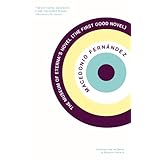
Average Reviews:

(More customer reviews)Argentinian author Macedonio Fernández (1874-1952), though largely unknown in the English-speaking world, has been something of a cult figure to several well-known Latin American authors of the twentieth century, including his protégé, Jorge Luis Borges. "The Museum of Eterna's Novel (The First Good Novel)" was commenced in 1925, went through five drafts, and remained in an unedited, unfinalized state at the time of Fernández's death. Like many other writers of the Modernist era, Fernández sought to reinvent the rules of the novel, starting with a very basic premise: Why risk love when death is inevitable? In tackling a question that has haunted countless thinkers before him, Fernández takes a deeply metaphysical approach that influences the very form of his greatest work. Dedicated to the caprices of the "Skip-Around Reader," whom Fernández claims will unwittingly find themself reading in order, "The Museum of Eterna's Novel" is a work of philosophical metafiction that uses its medium to explore the cosmic complexities of human life and human love.
The bulk of "The Museum of Eterna's Novel" is not a novel at all, but a series of prologues, some fifty in total, with titles such as "Prologue That Thinks it Knows Something, Not About the Novel (It's Not Allowed That), But About the Doctrine of Art," "The Man Who Feigned to Live" (which is one big footnote), and "For Readers Who Will Perish if They Don't Know What the Novel is About." Some meditate on the process of creating "The Museum of Eterna's Novel" from the perspective of both the author and the characters, including the cook who decided to resign and left the remaining characters with nothing to eat. Other prologues, in dense and difficult but ultimately rewarding prose, set up the mystical underpinnings of the main story.
The actual novel takes place on an estancia called "La Novela," owned by the President, who has gathered together his closest friends, including Maybegenius, Sweetheart, The Lover, Simple, the Gentleman Who Does Not Exist, and Eterna, who is both the President's love interest and the personification of idealized beauty and eternal love. There, the characters exist in the moment and only for each other, spending each day in one another's company and speculating on the nature of companionship and eternity. And here we come to the crux of the matter: the definition of "Totalove," the theme connecting all the musings and mind exercises of both prologues and novel. Fernández describes it as "the Highest form of Daydream." It is a rapturous state of passion that prevails only in the present and is the ultimate form of love: for a beloved, for friendship, or for art and beauty. The problem then becomes how to sustain a moment that is only that: a moment. The Action (in this case, the conquest of Buenos Aires by beauty, initiated by the President) is only one aspect of Totalove. There is also the anticipation, like the weeks building up towards Christmas and the sadness one feels after the presents have been opened and the rest of the day still remains. Once the Action has occurred, there is nothing left but loss or even death.
Hence the prologues: "The Museum of Eterna's Novel" is a novel that doesn't want to begin because in our beginning is our end.
Clearly, Macedonio Fernández was a fascinating, complicated man. "The Museum of Eterna's Novel" is a brilliant, thoughtful and frequently hilarious work that brings to mind everything from Mark Twain's irreverent humor to Jorge Luis Borges's mental labyrinths to Edgar Allen Poe's preoccupation with death and idealized beauty. I'll warn you: it's a difficult read, but if you're up to the challenge, this book is truly worth it.
* Review copy *
Click Here to see more reviews about: The Museum of Eterna's Novel
The Museum of Eterna
Click here for more information about The Museum of Eterna's Novel

No comments:
Post a Comment